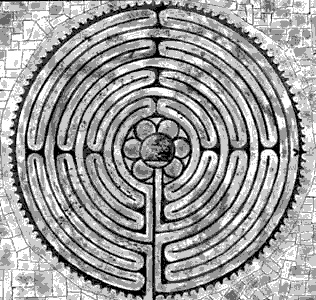I spent some time mulling over how on earth to make the labyrinth permanent — but without spending a lot of money. Labyrinths can cost into the six-figure range and even higher, as you can see by clicking on to this link: http://www.labyrinthproject.com/pricerange.html
My preferences fell into the under-$1,000 range. After a wide-ranging Internet exploration, I was taken with the labyrinth at the convent of the Sisters of St. John the Divine in Willowdale, Ontario. I walked it one chilly day in winter several years ago while on a retreat. In fact, I wrote a poem about it earlier in this blog.
Here is a picture of their 11-circuit labyrinth. The path is a bit too narrow for my liking, but the mulch works well, and I like the rocks.
 |
| Source: http://www.ssjd.ca/labyrinth.html |
This is the URL for a description of how the sisters constructed their labyrinth: http://www.ssjd.ca/labyrinth.html
When I consulted with Rick, our landscaper, about how to make the paths of the labyrinth permanent, he had a few suggestions that seemed to fit the bill and one that, as it turned out, didn't.
He recommended using an 18-inch sod cutter to remove about two inches of thatched grass and roots. On top of the newly scalped path would go a layer of mulch to squelch the weeds.
The question was how much mulch. I determined the diameter of the labyrinth, and then Rick estimated six cubic yards would fill the path. As it turned out, we have some to spare but better than not having enough.
So this is how it all played out: First of all, the heavy equipment arrived. The young guy is trundling the sod cutter off the trailer.
The dump truck backed down to the labyrinth; six cubic yards seems ... well ... a lot; we won't run out for a while!
Down it went into a handy pile:
I suggested starting to cut the sod first from the centre and then going outwards would be easiest, as the turns would get progressively less tight. Also, they would end up with the cutter in the open not in the middle of a series of trenches to bump over in order to extricate it. However, after providing them with this illuminating advice, I left them to their own devices. Men seem to appreciate that.
There is no doubt that lifting sod is heavy work.
Eventually, using the wheelbarrows got too onerous, and the front loader was brought in to help haul the sod bits to the sod pile.
When this all breaks down, I'll have some really great compost.
This is what the finished path was like. We plan on putting rocks beside it. Fortunately there are a lot of rocks on PEI. More on that later.

It felt good to walk the labyrinth. You may be wondering if I ever change my gardening clothes. The answer is no. You may also be wondering what I was carrying. It was a piece of plastic, which Rick felt we should put under the mulch to deter the weeds.
I experimented with the plastic sheeting, but it felt very slippery underfoot. We have an endless supply of mulch, so adding more next spring might be the better plan. As a result, I decided not to use it after all. We now have the rest of a box of house wrap for our as-yet-to-be-built garden shed.
Next step was spreading the mulch. This necessitated buying a wheel barrow. I digress, but I may fill you in later, as this decision is a story in itself.
Anyhow, next time I would take a look at the mulch before buying it sight unseen. This has a few too many sticks in it, but frugal soul that I am, I will separate them for use as kindling.
It took me about four or five hours, spread over as many days, to carry and spread the mulch. This is our handy light-weight, two-wheel wheelbarrow.

The next challenge will be what to do about the rocks for the edge of the path.











































